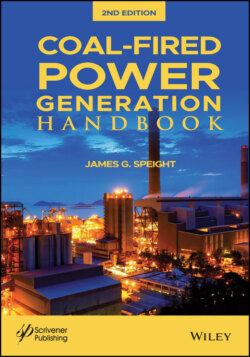Читать книгу Coal-Fired Power Generation Handbook - James Speight G., James G. Speight - Страница 53
3.2.1.3 Contour Mining
ОглавлениеContour mining occurs on hilly or mountainous terrain, where workers use excavation equipment to cut into the hillside along its contour to remove the overlying rock and then mine the coal. The depth to which workers must cut into the hillside depends on factors such as hill slope and coal bed thickness. For example, steeper slopes require cutting away more overburden to expose the coal bed.
The contour mining method consists of removing overburden from the seam in a pattern following the contours along a ridge or around a hillside and prevails in mountainous and hilly terrain. If a coal seam is visualized as lying level at an elevation of 100 feet above sea level, and the land surface elevation varies from 600 to 1400 feet above sea level, a contour-stripping situation exists. Mining commences where the coal and surface elevations are the same (the crop line) and proceeds around the side of the hill on the crop line elevation.
The earth (overburden) overlying the coal may be removed by shovel, dragline, scraper, or bulldozer, depending on the depth and overburden character. The overburden is cast (spoiled) downhill from this first pit, after which the exposed coal is then loaded into trucks and removed from the pit. A second pit can be excavated by placing the overburden from it into the first pit.
Succeeding pits, if any, would follow in the same sequence, with the amount of overburden increasing for each succeeding pit until the economic limit of the operation, or the maximum depth limit of the overburden machine, is reached. This economic limit is determined by many variables, some of which are thickness of the coal seam, quality, and marketability of the coal, nature of the overburden, capabilities of the equipment, and reclamation requirements.
The practice of depositing the spoil on the downslope side of the bench thus created has, for the most part, been terminated because the spoil consumed much additional land and created severe landslide and erosion problems. To alleviate these problems, a variety of methods were devised to use freshly cut overburden to refill mined-out areas. These haul-back or lateral movement methods generally consist of an initial cut with the spoil deposited downslope or at some other site and spoil from the second cut refilling the first. A ridge of undisturbed natural material is often left at the outer edge of the mined area to add stability to the reclaimed slope by preventing spoil from slumping or sliding downhill.
Once the hill slope prevents further cutting into the hillside, miners often switch to a technique known as auger mining to extract more coal along the contour.
